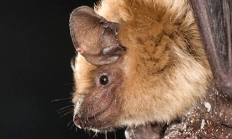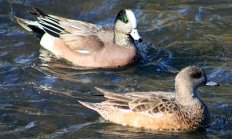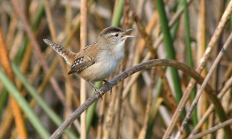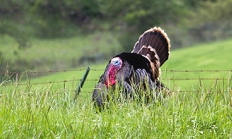Search myodfw.com
The Snow bunting is a large finch that breeds throughout the high arctic tundra. In winter, many move south, sometimes forming large flocks in open grasslands, steppes, and dunes. When feeding in agricultural fields, these flocks may be hidden among the stubble, but when alarmed they often arise as a group and whirl about in a white cloud before returning to their spot or a nearby one. Oregon is at the southern edge of their winter range, and their wanderings about the state are erratic. In basic plumage, they are buffy and cream-colored with black and white wings. Hear the

The Mink is a semiaquatic species. The body is elongate and cylindrical, the legs are short and stout, the tail is bushy and about half as long as the head and body. The head is flattened, the ears small and rounded, and the nose is pointed. The pelage consists of dense grayish underfur and long lustrous guard hairs. Dorsally, it is dark brown to blackish but somewhat lighter on the venter. In Oregon, the mink is found throughout the state and is associated with river, lake, pond, or marsh environments. They forage along overhanging banks, and in holes and crevices

Columbian sharp-tailed grouse, commonly called "prairie chickens" by early Oregon residents, were abundant in the grasslands and foothills of Oregon east of the Cascade Mountains prior to the late 1800s but were considered extirpated from the state by the 1970s. Recent reintroduction programs give a glimmer of hope that sharp-tails may once again hold their own in northeast Oregon. Males congregate on leks or dancing grounds in the spring and perform elaborate social displays. The Columbian sharp-tailed grouse is an Oregon Conservation Strategy Species in the Blue Mountains ecoregion. Hear the call of the Columbian sharp-tailed grouse Photo by Mike

Insects swept up in a rising air mass are favorite prey of this species nicknamed the "cloud swift." It prefers to nest near or even behind the curtain of a waterfall. This dark swift glides for long distances, often very high in the sky, with its wings held somewhat downward. It is larger and darker than the more common Vaux's swift, and has a slightly forked tail. The Black swift is a rare to uncommon spring and fall transient and summer visitant throughout the state. It's an Oregon Conservation Strategy Species in the West Cascades ecoregion. Hear the call of

Ravens are clever, innovative, and entertaining. They quickly exploit human-created opportunities for food and shelter. Their spectacular aerial acrobatics conducted under windy or thermal conditions appear to be an act of fun. The Common raven's plumage is entirely shiny black like the American crow, but the ravens appear 25 percent larger, have a wedge-shaped tail and have deeper croaks and other calls than the American crow. In Oregon, the Common raven is a fairly common, widespread resident in many habitats throughout the state; population densities are highest east of the Cascades. Hear the call of the Common raven Photo by

This large sparrow is white below and in most plumages has at least some black around the face or throat, more in adults than younger birds. Cheeks are golden-tan in fall and winter and grayish in spring. It is streaked above. It is a winter visitor usually found with other sparrows. A very rare migrant and rare but regular visitor, you can find the Harris's sparrow statewide. Numbers vary considerably from year to year, but a few birds are typically found in the state every year. They are most regular in the Columbia Basin and in valleys within the Blue

The big brown bat is a relatively large bat with a wingspan of 13 to 14 inches. Its dark color and slow flight help with identification. They are more likely to be active in cold weather than other bats and prefer human structures for roosting. The big brown bat occurs throughout the state. In eastern Oregon it forages over the forest canopy, along roads through the trees, along the forest edge, over forest clearings, and along cliffs and canyon streams. In western Oregon, the species is usually associated with coniferous and deciduous forests. Photo by ©Michael Durham

The sagebrush vole is among the smaller voles in the state. The tail does not exceed the length of the hind feet. The long, soft, and dense dorsal pelage is grayish tan; the bases of the hairs are lead colored and the tips are black. The ventral pelage is pale buff, the feet light gray, and the tail slightly bicolored. In Oregon, it occurs mostly east of a line connecting The Dalles, Bend, and Klamath Falls, except it is absent from the Columbia Basin and most of the Blue and Wallowa mountains. Clustering of burrows tends to indicate that the
Inconspicuous and master of stealth, the Least bittern inhabits densely vegetated deep-water marshes, making observations rare and difficult; its call is often the only way to detect this secretive species. The smallest of herons, its long neck and legs make it appear larger. The crown, back and tail of male birds is greenish black; purple-chestnut on female. Neck, flanks, and underparts are brown and white and the wings buff. It is a rare spring and summer resident in larger freshwater marshes of eastern Oregon and a very rare spring through fall visitor in the Rogue and Willamette valleys. At Upper

Wigeon drakes are beautifully marked with white pate, green eye stripe, purplish breast and flanks, white belly and wing covert patch, and iridescent black/green speculum. The grayish hen shows white on the wing covert patch. Drakes give a three-note whistle and get progressively noisier as spring approaches and courting flights begin. Medium sized flocks are common in fall and winter, and like geese, will be found grazing pastures, park lawns, and golf courses. It is a rare to locally common breeder in eastern Oregon and rare in summer in western Oregon. It is a common to abundant migrant and wintering

This pugnacious little wren, formerly known as the Long-billed marsh wren, inhabits cattail, bulrush, and other marsh plants. As the only Oregon species of wren that nests over water, it is easy to identify when seen, but sexes are difficult to differentiate in the absence of song due to similar coloration. This species has long been of interest to behavioral and evolutionary ecologists due to its polygyneous mating system, widespread construction of dummy nests, and the male's complex singing behavior. The Marsh wren nests statewide in appropriate wetland habitats. It is particularly common during breeding season around Malheur National Wildlife

The Brown-headed cowbird was referred to in early literature as the "buffalo bird" presumably because it commonly foraged on insects flushed under the feet of ungulates. It is a brood parasite, laying its eggs in nests of other species and leaving the rearing of young to surrogate parents. This has had serious consequences for many host species within the cowbirds' range. In Oregon, the Brown-headed cowbird is a common migrant and breeder in open habitats and woodland edges in all parts of the state. It is most abundant in agricultural land, sagebrush and juniper steppe, coastal scrub, riparian zones, and

In Oregon, the opossum is considered an invasive species. The Virginia opossum is a cat-sized mammal with a pointed nose, unfurred, black, leathery ears with white edges; beady eyes; a hind foot with an opposable hallux (big toe); and a naked scaly tail. It was introduced in Oregon between 1910 and 1921. Populations were established in northwestern Oregon apparently from releases of animals brought to the state as pets or novelties. Small streams, forest communities, and agricultural lands planted to a variety of crops are typical of many habitats occupied by Virginia opossums in Oregon. They are active nocturnally and

The vagrant shrew can be distinguished from all other congeners in Oregon by the combination of the upper unicuspids wider than long in ventral view. It is light medium brown on the dorsum, light pinkish-gray on the sides, and white on the venter, bases of hairs on all three areas are neutral very dark-gray. The tail is weakly bicolored (dark brown over white) in juveniles. The vagrant shrew occurs throughout the state except in the Columbia Basin. It tends to be more of a generalist than most Oregon shrews in terms of habitat affinities, nevertheless, it usually is found in
A slender, orange bill, pearl gray upperparts, and fringed black crest adjoining a white face and neck indeed render this graceful hunter from the south elegant. The foreheads of adults turn white in post-breeding plumage, their usual state in Oregon. These terns frequent quiet waters or lagoons when diving for fish, but also dive in calm ocean waters. They roost with flocks of gulls and other terns on coastal spits, estuarine sandbars, and on mudflats close to bay mouths. Virtually all records of the Elegant tern in Oregon are coastal or within half a mile of shore. None have been

With its long, forked tail and long wings, it is the most graceful of all land birds and reminds one of the smaller terns not only in shape but in behavior. The Barn swallow has taken so completely to nesting on human-made structures that one forgets they were once restricted to caves and rock crevices. Almost every farm in the state has a pair or two nesting in an outbuilding, and very few bridges do not have a pair or two. It is the best known of the swallows. It is a fairly common to locally abundant summer resident and

Ruffed grouse are named for a series of black iridescent feathers on the sides of the neck called the ruff, which is erected by males to form an ring around the neck during courtship displays. This forest-dwelling species, favored by upland game-bird hunters, is well known for the drumming of the males during courtship displays in the spring. It is a common resident throughout most forested regions of the state. It occupies most forests at low to moderate elevations east of the Cascade crest, primarily the east slope of the Cascades from Ft. Klamath and upper Klamath Lake and Blue

The wild turkey is the largest game bird in North American with mature males weighing upwards of 20 pounds and standing 40 inches tall. These large terrestrial birds are generally dark brown to black in appearance but iridescent color in feathers ranging from gold and copper to green and black gives a metallic appearance, particularly in full sunlight. Males and about 10 percent of females sport a unique beard of keratinous filament that protrudes from the junction of the breast and neck. Beards grow continuously but rarely exceed 10 inches in length. Females are smaller and duller in appearance. Densities

These small, fast flying seabirds are unique among alcids in North America in their use of coastal coniferous forests, primarily old-growth trees, as nesting habitat. Their solitary nests are usually concealed within the forest canopy, and breeding birds are cryptic and primarily crepuscular at nest sites. Because of their secretive behavior and elusive nests, Marbled murrelets were considered the "enigma of the Pacific" and were one of the last ornithological mysteries in North America, as the first nest was not discovered until 1974. Distribution at inland nesting sites is fragmented, as birds occur only in areas where suitable habitat remains

